Vintage fabrics are fabrics that were produced from 1920's to the 1970's. When Vintage fabrics are mentioned, most of us think of the 1930's feed sacks and their reproductions today, however, this is just a tiny part of the the vast collection of vintage fabrics.
Here are some illustrations of vintage fabric and some links that you can go to to get more ideas of just what vintage is. I bet you have some in your stash or I bet you have a relative that has some you can get your hands on. :o)
1920's

1920's fabrics included linen, cotton, and wool mixed with acetates, rayon and pure silk. Daytime clothing was medium to lightweight in crepes, knits, and light suiting with natural color tones of browns, blues and grays. Evening wear meant silk, in sheer chiffon and denser fabrics boasting of more vivacious colors. Prints for both day and night were common but as small, checks or floral.
The designs of the 20's were those of the Art Deco movement. They were very geometric, simple but dramatic with dark and light contrasts.
Quilts of the 1920s reflected the economic affluence of the decade. Fancy embroidered quilts on hand-spun Chinese silk like this one continued the favorite garden motifs.
1930's
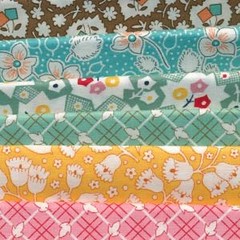
The fabrics of the 1930's are by far the most popular of the vintage fabrics and it isn't hard to see why. During these times of economic hardship attentions was returned to the home and family and the homemaking arts. The whimsical designs and bright array of colors make them eye-catching and fun to work with.
During the 1930's, a quilt revival took place. The need to be thrifty, coupled with a strong need for socialization, brought women from across the country together around their quilting frames. During this time Eleanor Roosevelt ran a campaign for American Arts and Crafts. Her efforts brought a lot of attention to quilting and the fabrics used in it. Quilt patterns began appearing in local newspapers and sales catalogs. Newspapers and catalogs also advertised and delivered the necessary fabric and supplies the women needed.
"It's an ill depression that blows no good... without money for costly diversions, the women have turned to a renewal of quilt making. Many of the household magazines and not a few of the daily papers have quilts and pattern departments and are offering every inducement for the continuation of this most interesting of home-crafts arts."-- Carrie Hall, quilter
World War I also played an important roll in the fabrics of the 1930's. Germany had long held the patents for pastels. This is why the fabrics of the 20's had not been so bright and exciting. With the surrender of Germany came synthetic dye patents and Pinks, Blues, Yellows, Greens, Reds, Aqua, Peach, and Lavender began appearing on cotton goods containing popular designs: flowers, geometrics, conversationals, and Art Deco motifs.
According to Quilt Historian Sharon Newman, author of the book Treasures from Yesteryear, the designs of the previous decade, the 1920's, were smaller, closer together, and overall more dense. But by the 1930's, prints had a bit more space around the designs with white grounds. Some of those trends continued in the 1940's. Fabrics saw even larger designs, more conversationals appeared, and many patriotic or military type themes became increasingly popular.
1940's
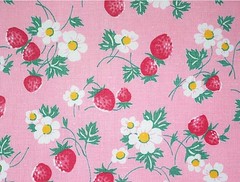
WW II heavily influenced the fabrics of the 1940's. With the Occupation of France came drastic changes to the fashion industry. In 1940, 'The Limitation of Supplies Order' was enforced. This meant that the amount of cloth used in an item of clothing was regulated. The shortage of fabric during the war shaped the slim silhouette we recognize from the 1940's.
There may have been less of the fabric to use but they made up for the lack with bigger and bolder prints.
1950's

The end of WWII brought women back from the work force to the home. It was the hay day of the America House Wife. It was also a time of more affluence. It was reflected in the fabrics. Bigger and bolder prints with plain backgrounds changed to bright and multi colored backgrounds. They fabrics also reflected the commercial push of the nation. They show scenes of home and family life in dramatic styles and colors. Bubble gum pink was a popular color at this time.
1960's
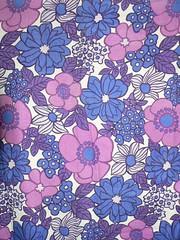
The 60's were a turbulent decade. The issues and new ideas made their way into the fabrics too. The commercial fabrics of the 50's gave way to bright florals and nature scene fabrics of the "new" movements. The prints ranged from small tight florals (similar to those of the 2o's only in bright wild colors) to florals the size of dinner plates.
Quilts were still being made in the 60's but mostly by mothers and grandmothers. Young women were finding other things to do and learn about outside the home.
1970's
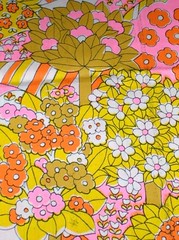
The fabrics of the 1970's continued on the bright and wild themes introduced in the 60's. They also showed a renewed interest in fabrics and motifs of the past. With the bicentennial in 1976 came a wave of patriotic fabrics depicting early Americana life. The fabrics were also influenced by an ever growing ethnic and cultural awareness. Fabric prints depicting images from other cultures made their way into the fabric departments of stores.
Quilted bed covers officially became "art" in 1971, when the groundbreaking exhibition "Abstract Design in American Quilts" opened at New York City's Whitney Museum of American Art.
I hope this brief lesson on fabrics that qualify as Vintage, helps you in your quest for vintage fabrics for the exchange in June.
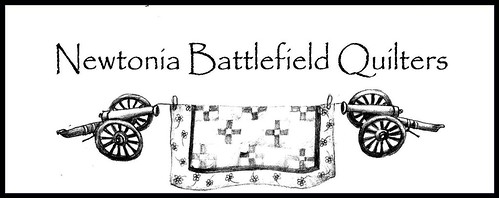
No comments:
Post a Comment